ISSN ONLINE(2278-8875) PRINT (2320-3765)
ISSN ONLINE(2278-8875) PRINT (2320-3765)
N.Vijayasarathi1, S.Santhiya2
|
| Related article at Pubmed, Scholar Google |
Visit for more related articles at International Journal of Advanced Research in Electrical, Electronics and Instrumentation Engineering
The class Φ2 inverter is a new switched mode type of resonant inverter. This inverter is applicable for very high frequency application. In this paper, it proposes class Φ2 inverter reduced the voltage stress, and improve the dynamic response. The class E resonant inverter is not suitable for high frequency application, because it produce high voltage stress across the switch. The suitable ballast and parallel resonant tank is prepared for class Φ2 inverter. By Comparingwith class E inverter, the class Φ2 has more dynamic response and low switching voltage losses.
Keywords |
| Zero Voltage Switching (ZVS), Class Φ2 resonant inverter. |
INTRODUCTION |
| Resonant inverters have been widely used in consumer electronics, telecom power supplies, and electronic ballasts. Compared with the PWM converters, it has many advantages, such as low EMI, low switching loss, and high power density. The resonant tank can be of various topologies including the commonly used ones such as parallel resonant tank, series resonant tank, LCC, LLC and LC-LC resonant tanks. Class D is one of the power stage prototypes of electronic ballast. Also half bridge topology has extensively applications in ballast. The high efficiency and simplicity allow the half bridge inverter widely used in electronic ballast. Compared with half bridge topology, class E inverter only has one switching component, higher efficiency and simpler drive circuit. The class E has a very extensive application in electronic ballast. However, the choke inductor in class E limits the dynamic response and the switching voltage stress is also high, which is almost 4.4 times the input voltage. In Recent years, the developed a new resonant inverter called class Φ2 inverter which reduces the voltage stress and replaces the choke inductor with a resonant element thus largely improves the dynamic response. Therefore class Φ2 inverter is another attractively alternative prototype used in electronic ballast. However, the inductor in output portion of class Φ2 inverter is series with load, which is unsuitable for producing a high output voltage pulse during ignition of the lamp. To overcome the problem with ignition, a parallel resonant tank has been connected to class Φ2 inverter and presented in this prototype electronic ballast. |
| Ref [1] gives an overview controlled resonant dc–ac inverters, with class E amplifier and frequency multipliers. The main advantage of the resonant power conversion technique is ability to eliminate turn on or turn off loss on semiconductor power devices, so that the converter can operate efficiently. This presents a detailed procedure for determining the characteristic values of the power components of a high output voltage DC-DC series-parallel resonant converter in the controlled circuit. The result is improved the dynamic response [2]. Phase-controlled resonant dc–ac inverters with class E amplifier and frequency multipliers. These inverter with amplifier on the same switching frequency. The measured efficiency was over 93% at an output power of 0.98 W and a switching frequency of 0.5 MHz for both of the inverters with amplifier and frequency double [6]. Class Φ2 inverter with the designed control circuit to regulate the lamp current continuously using variable frequency control, a low lamp CF is achieved while maintaining a high input power factor [7]. This implemented with the resonant tanks of the electronic ballast being capacitive and inductive, which can achieve lower switching losses, lower conduction losses [8]. |
II.CLASS Φ2 RESONANT INVERTER |
| Parallel resonant inverter is the dual of a series resonant inverter. It is supplied a current source so that circuit offers a high impedance to the switching current. A parallel resonant circuit current is continuously controlled inverter. This inverter gives a better short-circuit protection under the fault conditions. The proposed switched-mode resonant inverter, which we term as class Φ2 inverter. |
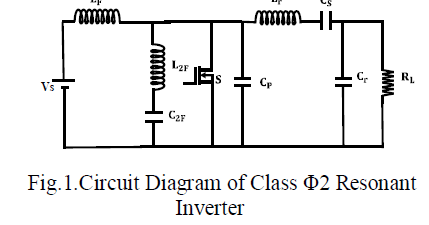 |
| In this paper we use a recently-developed single-switch ZVS inverter topology that overcomes the limitations described above. The so-called Φ2 inverter (shown in Fig.1) introduced in is a highly simplified variant of the class Φ inverter Hence we can obtain the vac as follows |
 |
CLASS Φ2 MODES OF OPERATION |
| The single stage, single switch high power factor electronic ballast, integrates and resonant inverter stage. The active power switch of the proposed electronic ballast is excited by the driving signalïÿýïÿýïÿýïÿýïÿýïÿý. The duty cycle of the driving signal is d. The circuit operation can be divided into two modes in accordance with the conducting power switch within one high-frequency cycle. |
A.Mode1: Switch is ON |
| To turn on signal is applied to the gate of the switch S. The equivalent of this mode is depicted in Fig.2. Once S has been turned on, the line voltage is imposed on the inductor Lf. The inverter which to increasing the output voltage and current. The resonant tank will be operated at boosting method the inductor ïÿýïÿýïÿýïÿý will also charge at fully conditions. |
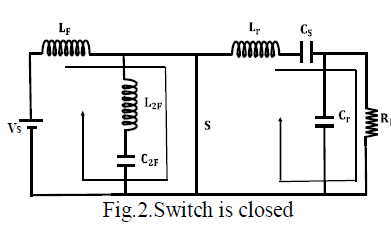 |
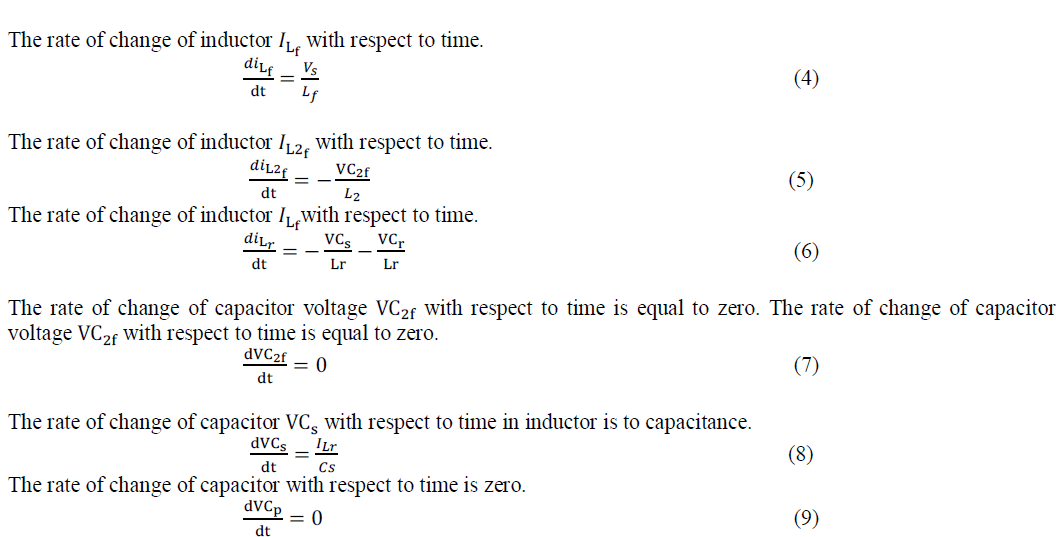 |
B.Mode2: Switch is OFF |
| When the switch is off means the inductor get discharged. This is to lead the output voltage. The capacitor also discharged through the load. The switch off means the ïÿýïÿýïÿýïÿý will be present. It will be produced negative half cycle.This is the analysis of the switched on and off conditions. |
| The dc-link capacitor Cïÿýïÿýïÿýïÿýis assumed to be sufficiently large. So that the dc-link voltage Vïÿýïÿýïÿýïÿý can be considered as an ideal dc voltage source. This is the analysis of the switched on and off conditions. The inductor ïÿýïÿýïÿýïÿýis large enough that the inductor current Iïÿýïÿýïÿýïÿý can be approximated as a dc current source. |
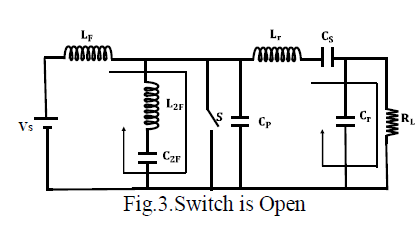 |
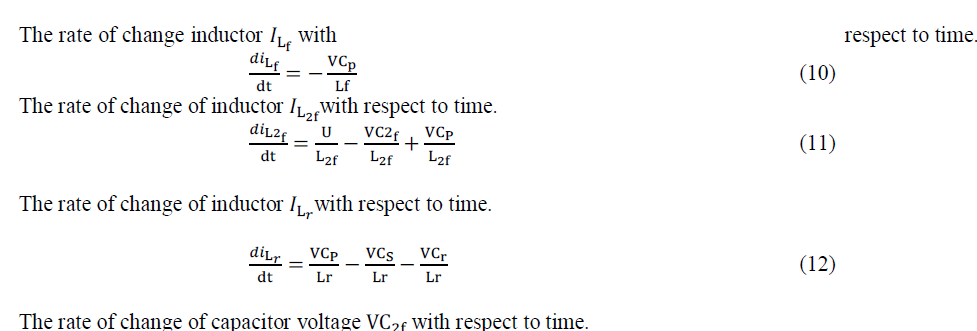 |
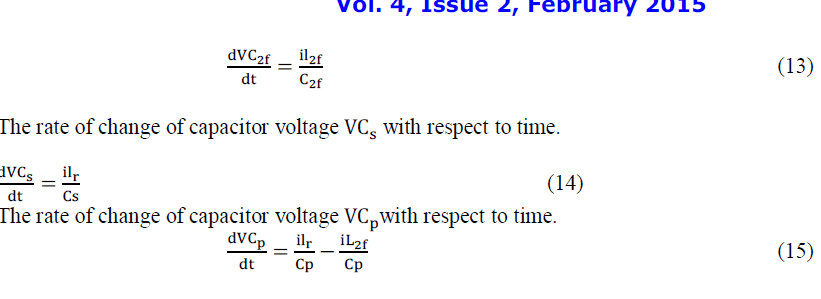 |
III.SIMULATION RESULTS OF CLASS Φ2 INVERTER |
| The closed loop systems are designed to automatically achieve and maintain the desired output condition by comparing it with the actual conditions. It does this by generating and error signal which is the difference between output and the reference input. |
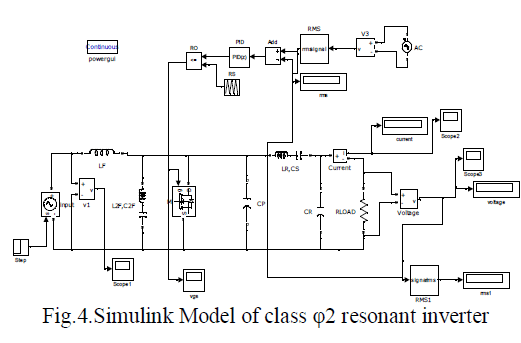 |
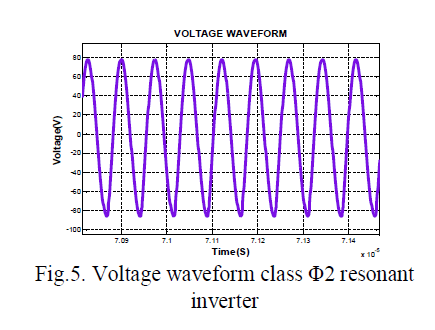 |
| Fig 5.The input voltage is vin =12v; the output voltage is v0=100v;The open loop output voltage is 48v; and the closed loop of output voltage is 100v.The switching frequency is 13.56 Mhz.The resonant inverter generates a high frequency ac voltage and dc component. In the resonant tank, the dc blocking capacitor prevents the dc current. By the resonance of inductor and capacitor, a high voltage pulse is generated to ignite the lamp. |
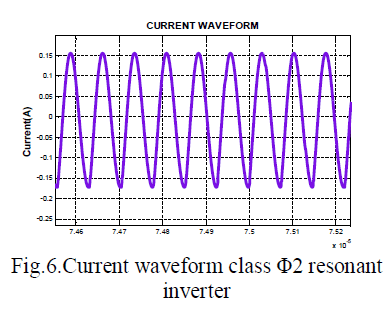 |
| In figure 6 is the output current waveform in closed loop control system. The output current waveform is pure sinusoidal output waveform. It produced output current is ïÿýïÿýïÿýïÿý=0.15 amps. This is the output wave form for closed loop control of class Φ2 resonant inverter. |
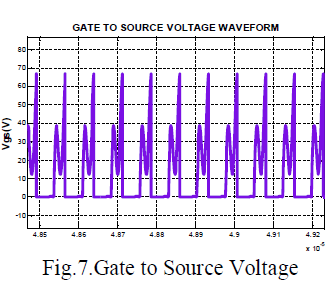 |
| The resonant inverter generates a high frequency ac voltage and dc component. In the resonant tank, the dc blocking capacitor prevents the dc current. By the resonance of inductor and capacitor, a high voltage pulse is generated to ignite the lamp. |
Electronic Ballast Advantage |
| Electronic ballasts for fluorescent lighting systems have fast become the standard in the industry and further advancements continue to increase the benefits of using electronic ballasts. |
| Following is a summary of the many advantages of electronic ballast technology: |
| ïÃâ÷ Ability to Drive More Lamps |
| ïÃâ÷ Reduced Cooling Load |
| ïÃâ÷ Reduced Lamp Flicker |
CONCLUSION |
| The class Φ2 inverter is implemented in this project and it is suitable at very high frequencies and rapid on/off control. The suitable ballast and class Φ2 inverter with the parallel resonant tank is prepared for fluorescent lamp driver. Compared with traditional ballast based in class E, the class Φ2 can effectively improve the dynamic response & reduce switching Voltage stress. Hence it is proved by the closed loop simulation, the performance of the class Φ2 inverter was improved by using closed loop performance. The open loop simulation that provides output voltage of 48v and it varies as the load is disturbed. The dynamic response was improved by using PID controller and it provides constant output voltage is 100v; and it reduced the voltage stress. |
References |
|